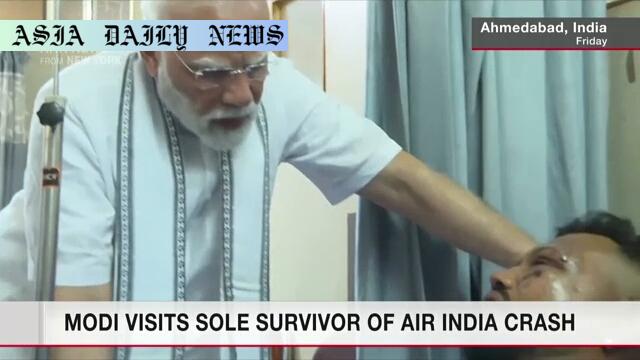Air India crash: Indian PM Modi meets sole survivor, urges strong actions for the investigation and victim recovery efforts.
Indian PM Modi visited the sole survivor of the Air India crash.
The crash involved a 787 Dreamliner jet, leaving 247 dead and 50 injured.
India’s aviation minister confirmed black box recovery.
US investigators collaborate on understanding the accident.
The plane struck a college dormitory, causing further casualties.

Indian PM Modi Visits Site of Tragic Crash
In the wake of a devastating Air India plane crash, Indian PM Narendra Modi visited the crash site on Friday and consoled the only known survivor, Viswashkumar Ramesh. The tragic crash, which ripped apart a 787 Dreamliner bound for London, claimed the lives of 242 passengers aboard and caused destruction on the ground. Ramesh, a British citizen of Indian origin, courageously recounted his survival noting how he found a small escape route and fled through the wreckage.
PM Modi praised the resilience of Ramesh and reiterated the government’s full support to uncover the causes behind the crash. His visit reaffirmed the priority of both safety measures for air travel and support for crash victims and their families.
The Consequences on the Ground
The accident had far-reaching consequences as the plane’s impact destroyed parts of a college dormitory, adding further to the already horrifying death toll. Reports confirmed at least five fatalities and fifty injuries on the ground, though there remains concern that many may still be trapped under the debris. The aftermath has strained emergency services, but significant efforts are ongoing to uncover all affected areas.
Recovery of the Black Box
In a critical step, Indian aviation officials announced the recovery of the black box, a crucial part of investigating the reasons for airline tragedies. Minister Ram Mohan Naidu commended the progress made by these initial efforts, while urging swiftness and precision in the investigations. The US National Transportation Safety Board (NTSB) has extended its technical support by sending a team of investigators to India to help decipher the crash’s complex details with their specialized approach.
Boeing and International Relations
The Dreamliner in question is a marquee product of Boeing, a global aerospace titan. The company extended its condolences to the victims and pledged full cooperation with Indian authorities. International aviation doesn’t operate in isolation, and this crash has underlined the criticality of cross-border collaboration for air safety improvement. The moment reinforces the need for manufacturing and regulatory bodies to align robust safety standards.
The Way Forward
The crash unquestionably raises urgent questions about aviation safety, leading experts to believe that lessons from this will aid in the institution of even stricter operational protocols. For India, a country with rapidly increasing flight traffic, focusing on infrastructural upgrades, routine checks, and pilot training is of utmost importance. The probe outcome will be WATCHED closely on an international scale given European and US safety institutional involvement.
This tragedy is a stark reminder of the fragility of air travel security and the necessity for swift, coordinated action whenever such disasters occur.
Commentary
PM Modi’s Timely Visit Provides Reassurance
Indian Prime Minister Narendra Modi’s visit to the crash site demonstrates not just symbolic leadership but also a reassuring presence for those affected by the devastating Air India crash. In moments of large-scale national tragedy, visible leadership can help unite a grieving populace. The visit serves as a reminder of Modi’s commitment to safety reforms and his determination to address the crisis head-on.
The Unfolding Impact of the Crash
Beyond the immediate statistics of loss and survival, this incident highlights deeper concerns within aviation management globally. The crash’s impact on a residential area raises alarms regarding airport proximity protocols and flight operation standards. The road ahead for investigators and policymakers is future-proofing aviation frameworks while addressing local urban planning needs.
Global Cooperation for a Safer Future
The involvement of Boeing and the US NTSB underlines the essential role of global collaboration in addressing air catastrophes. No nation can effectively tackle aviation safety challenges single-handedly. International partnerships bring technological depth, expertise, and neutrality, often crucial in deriving unbiased conclusions.
This moment of tragedy brings forth a painful reckoning but also represents a potential turning point in enhancing the safety and operational standards of airlines worldwide. Every life lost reminds us of our collective responsibility to prioritize safety in an increasingly connected world.


